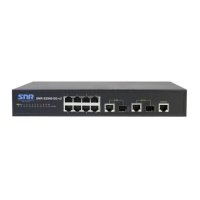SNR S2940-8G-v2 Switch Configuration Guide
VLAN Configuration
• Saving network resources
• Simplifying network management
• Lowering network cost
• Enhancing network security
Switch Ethernet Ports can works in three kinds of modes: Access, Hybrid and Trunk, each
mode has a different processing method in forwarding the packets with tagged or untagged.
The ports of Access type only belongs to one VLAN, usually they are used to connect the ports
of the computer.
The ports of Trunk type allow multi-VLANs to pass, can receive and send the packets of multi-
VLANs. Usually they are used to connect between the switches.
The ports of Hybrid type allow multi-VLANs to pass, can receive and send the packets of multi-
VLANs. They can be used to connect between the switches, or to a computer of the user.
Hybrid ports and Trunk ports receive the data with the same process method, but send the
data with different method: Hybrid ports can send the packets of multi-VLANs without the VLAN
tag, while Trunk ports send the packets of multi-VLANs with the VLAN tag except the port native
VLAN.
The switch implements VLAN and GVRP (GARP VLAN Registration Protocol) which are de-
fined by 802.1Q. The chapter will explain the use and the configuration of VLAN and GVRP in
detail.
16.2 VLAN Configuration Task List
1. Create or delete VLAN
2. Set or delete VLAN name
3. Assign Switch ports for VLAN
4. Set the switch port type
5. Set Trunk port
6. Set Access port
7. Set Hybrid port
8. Enable/Disable VLAN ingress rules globally
9. Configure Private VLAN
10. Set Private VLAN association
11. Specify internal VLAN ID
125

